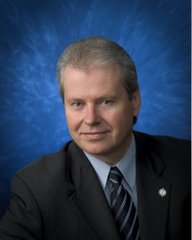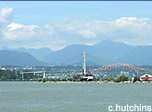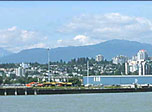It seems each
generation is called upon to defend hard-won freedoms and basic democracy. The worst aspects of human nature keep
rising, especially among those with bent ideas.
The adversaries are very right in their own eyes and will go to unusual
lengths to impose their hurtful ideas on others. We must educate ourselves about historic
truth, and remember and celebrate the good while recognizing the enemy.
First, we must
admit problems exist. We don't like to
admit it, but Canada has real enemies who mean us real harm. Worse, most Canadians have no idea of the
ideological dangers that threaten us, let alone the missiles already aimed at
major Canadian centres.
Some recent
immigrants understand this better than we do, having recently fled both
ideology and physical threats. But
Canadians live as though we're innocent bystanders to the rest of the world's
troubles. We must prepare each new
generation to defend itself against the next inevitable political-religious
assault that will come.
Indeed, it has
already begun. The social disorder and
conflict seen in our streets and universities are evidence of the active
undermining of Canada's cultural and intellectual foundations. History shows that past empires fall from
internal decay, magnified by outside hostile influences.
Marxist extremes
never go away as they just get rebranded.
The current DEI (diversity, equity, inclusion) fad from corporate
trainers is an example. DEI teaching
falsely claims to promote fair treatment and full participation for all people,
as particular groups say they have been historically underrepresented or
subject to discrimination based on identity or disability.
Although DEI is
best known as a form of corporate training, it has also found its way into
academia, schools, and the medical system.
Millions have been spent on this insidious fad. Yet, it has done nothing to improve our
social world. Instead, it has poisoned
intellectual discourse and undermined free speech and academic freedom. For good reason, it has been called cultural
Marxism.
One could make a
case study out of BC's adoption of the acid Sexual Orientation and Gender
Identity (SOGI) curriculum, developed by the education ministry. Introduced in 2016 by the then BC Liberals
(now BC United) it is administered province-wide, although teachers could
customize lesson plans as they saw fit.
The results were
often age-inappropriate or just odious propaganda. Naïve provincial politicians had no clue of
the sexually deceptive agenda they had just accepted. It was said to make schools feel safe for
everyone, regardless of how one expressed their gender. It declared itself against discrimination.
However, in the
hands of those implementing it, nice-appearing surface jargon became a pipeline
for social malevolence. Many parents
were horrified to learn it was an ideological Trojan horse. In defense of their children, parents made it
a big political issue in the hope that the next government would get rid of it.
It is often the
young who are targeted, in an attempt to bend malleable minds using the power
imbalance between student and teacher.
Those doing so, first use hard-won freedoms to make the case for every
debilitating social vice under the guise of anti-discrimination. Then the freedoms are gradually dispensed
with and traditional goodness is replaced by a new order and a new age of
totalitarian politically correct groupthink.
The remedy
however, is not to overthrow our educational structures, but for the community
to carefully monitor what is taught.
Using an extreme
case to illustrate the principle, National Socialism in Germany festered in the
context of the Russian Revolution and the Marxist provocations in that society.
The activities of the radical left were
no justification for the overreaction, but was an element responsible for the
'Mein Kampf response.' Extremism and lies breed more of the same.
Public education
is a delegated trust, and within a broad spectrum, there must be transparency
and accountability.
Good government
can become better, but poor government always descends from bad to worse. In Canada, that is where we are today.
We are
challenged by offshore ideas, agents, and countries that abhor the traditional
Canadian version of human rights, freedom, and democracy. To our peril, we don’t want to think about it,
but we must. There are real conflicts
with real tactics at the local community, national, and international levels.
Going beyond
describing problems, one has to know what our desired normal is. Most Canadians have concluded that our
present NDP-Liberal government is not the normal we should have for our
cultural and economic health. Conservatism in 2024 is the proper response,
but we must remember what it is, and not what non-Conservatives malevolently
misrepresent.
For example, in
a speech to a gathering of law enforcement officers, Pierre Poilievre said he
was prepared to consider a social defense of last resort to use the whole law
which includes the "Notwithstanding Clause" if found necessary to
defend the Criminal Code from a damaging court ruling. In response, non-conservatives set their hair
on fire, claiming the Charter of Rights and Freedoms was under threat and the
Conservative Leader had shown himself to be an anti-human rights demagogue.
Conservatism
seeks the truth that has emerged over time, drawing from the deep wellsprings
of human experience and building on proven foundations. It fosters order and the flourishing of human
beings as they live in benevolent relationships with one another. There is respect and a contract between
ancestors, the living, and the yet-unborn.
Conservatives
are not hard ideologues and blindly partisan advocates or impractical idealists
and theorists. In contrast, the
conservative mindset does not mainly seek to oust but to include. Anyone can destroy, but who can build? It is a conservative social project to build,
renew, sustain, and create through cooperation rather than coercion.
Conservatism is
rooted in the acknowledgment that God is our Creator and that the human soul
sojourns through this realm toward its eternal transcendent fulfillment. We are flawed human beings in need of
redemption, and capable of great evil as well as great good. As humankind is fallible by nature, the
conservative seeks to limit the damage done through the abuse of power by
limiting its concentration. The
conservative fosters the fullness of human potential by protecting the freedom
and dignity of each person, acknowledging that freedom comes with
responsibilities, as rights and duties are linked. Everyone is accountable.
For the
conservative, each person is equal in dignity and before the law, but
gloriously individual and unequal in talents, aptitudes, and outcomes. The conservative celebrates the uniqueness of
individuals and does not level to eliminate differences, yet intervenes against
injustice.
The conservative
honours the family as the essential building block of civilization. Conservatives value the rich diversity of
relationships, organizations, and private associations that make up civil
society.
The conservative
is more concerned with culture than politics because the political realm is a
derivative. Political problems arise
from the root of moral and spiritual problems, which blend into the economic
realm. Conservatives believe that caring
for our neighbor is so important that it should not be left to the government
alone. The bureaucracies of government
cannot love. That is why there is a
preference for the private sector, with our own time, talent, and
treasure. The best way to resist the problems
of big government is to do a better job with small government.
In the current
Canadian dilemma, a partial answer is found in the principles of the
Conservative Party of Canada Constitution.
It begins with a
belief in a balance between fiscal responsibility, compassionate social policy
that empowers the less fortunate by promoting self-reliance and equality of
opportunity, and the rights and responsibilities of individuals, families, and
free associations. The doubters and
cynics have never read the Conservative Party Constitution and also their
instructive Policy Declaration document.
But a more
complete answer would acknowledge that Conservatives believe there is truth and
that truth is knowable. They believe the
virtues of prudence, justice, fortitude, and temperance should be practiced in both
private and public life. Virtues, not
temporary values, define the human soul.
Love is the
highest motivation of the human person, and the purpose of life itself is to
know God, to love Him and serve Him, and to love our neighbor as
ourselves. Our ultimate fulfillment is
in the transcendence of love, so well put by the Lord Jesus Himself, when he
was asked what was the greatest commandment:
"37 Love
the Eternal One your God with all your heart and all your soul and all your
mind. 38 This is the first and greatest
commandment. 39 And the second is nearly
as important, Love your neighbor as yourself.
40 The rest of the law, and all the teachings of the prophets, are but
variations on these themes." (Matt. 22: 37-40, The Voice.)



.jpg)













